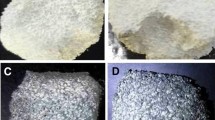Abstract
The purpose of this study was to investigate in vivo biocompatibility and osteogenesis as well as degradability of the porous strontium-doped calcium polyphosphate (SCPP) scaffolds as a biomaterial for bone substitute applications. The evaluation was performed on a rabbit model over a period of 16 weeks by histology combined with image analysis, X-ray microradiography and immunohistochemistry methods. The histological and X-ray microradiographic results showed that the SCPP scaffold exhibited good biocompatibility and extensive osteoconductivity with host bone. Moreover, a significant more bone formation was observed in the SCPP group compared with that in the CPP group, especially at the initial stage after implantation. New bone volumes (NBVs) of the SCPP group determined at week 4, 8 and 16 were 14, 27 and 45%, respectively. Accordingly, NBVs of the CPP group were 10, 19 and 40%. Immunohistochemical results revealed that both the expression of collagen type I and bone morphogenetic proteins in the SCPP group were higher than that in the CPP group, which might be associated with the release of strontium ions during the implantation. In addition, during 16 weeks implantation the SCPP scaffold exhibited similar degradability with the CPP scaffold in vivo. Both scaffolds showed the greatest degradation rate for the first 4 weeks, and then the degradation rate gradually decreased. The results presented in this study demonstrated that SCPP scaffold can be considered as a biocompatible material, making it attractive for bone substitute application purposes.








Similar content being viewed by others
References
Damien CJ, Parsons JR. Bone-graft and bone-graft substitutes—a review of current technology and applications. J Appl Biomater. 1991;2:187–208. doi:10.1002/jab.770020307.
Pilliar RM, Filiaggi MJ, Wells JD, et al. Porous calcium polyphosphate scaffolds for bone substitute applications—in vitro characterization. Biomaterials. 2001;22:963–72. doi:10.1016/S0142-9612(00)00261-1.
Grynpas MD, Pilliar RM, Kandel RA, et al. Porous calcium polyphosphate scaffolds for bone substitute applications in vivo studies. Biomaterials. 2002;23:2063–70. doi:10.1016/S0142-9612(01)00336-2.
Lee YM, Seol YJ, Lim YT, et al. Tissue-engineered growth of bone by marrow cell transplantation using porous calcium metaphosphate matrices. J Biomed Mater Res. 2001;54:216–23. doi:10.1002/1097-4636(200102)54:2<216::AID-JBM8>3.0.CO;2-C
Canalis E, Hott M, Deloffre P, et al. The divalent strontium salt S12911 enhances bone cell replication and bone formation in vitro. Bone. 1996;18:517–23. doi:10.1016/8756-3282(96)00080-4.
Buehler J, Chappuis P, Saffar JL, et al. Strontium ranelate inhibits bone resorption while maintaining bone formation in alveolar bone in monkeys (Macaca fascicularis). Bone. 2001;29:176–9. doi:10.1016/S8756-3282(01)00484-7.
Hott M, Deloffre P, Tsouderos Y, et al. S12911-2 reduces bone loss induced by short-term immobilization in rats. Bone. 2003;33:115–23. doi:10.1016/S8756-3282(03)00115-7.
Morohashi T, Sano T, Yamada S. Effects of strontium on calcium metabolism in rats i. a distinction between the pharmacological and toxic doses. Jpn J Pharmacol. 1994;64:155–62. doi:10.1254/jjp.64.155.
Grynpas MD, Marie PJ. Effects of low doses of strontium on bone quality and quantity in rats. Bone. 1990;11:313–9. doi:10.1016/8756-3282(90)90086-E.
Qiu K, Zhao XJ, Wan CX, et al. Effect of strontium ions on the growth of ROS17/2.8 cells on porous calcium polyphosphate scaffolds. Biomaterials. 2006;27:1277–86. doi:10.1016/j.biomaterials.2005.08.006.
Chen YW, Shi GQ, Ding YL, et al. J Mater Sci Mater Med. 2008;19:2655–62. doi:10.1007/s10856-007-3350-9.
Sous M, Bareille R, Rouais F, et al. Cellular biocompatibility and resistance to compression of macroporous beta-tricalcium phosphate ceramics. Biomaterials. 1998;19:2147–53. doi:10.1016/S0142-9612(98)00118-5.
Merkx MAW, Maltha JC, Freihofer HM, et al. Incorporation of three types of bone block implants in the facial skeleton. Biomaterials. 1999;20:639–45. doi:10.1016/S0142-9612(98)00219-1.
Dahl SG, Allan P, Marie PJ, et al. Incorporation and distribution of strontium in bone. Bone. 2001;28:446–53. doi:10.1016/S8756-3282(01)00419-7.
Yamada S, Heymann D, Bouler JM, et al. Osteoclastic resorption of calcium phosphate ceramics with different hydroxyapatite beta-tricalcium phosphate ratios. Biomaterials. 1997;18:1037–41. doi:10.1016/S0142-9612(97)00036-7.
Thorwartha M, Rupprechta S, Falkb S, et al. Expression of bone matrix proteins during de novo bone formation using a bovine collagen and platelet-rich plasma (prp)—an immunohistochemical analysis. Biomaterials. 2005;26:2575–84. doi:10.1016/j.biomaterials.2004.07.041.
Barbara A, Delannoy P, Denis BG, et al. Normal matrix mineralization induced by strontium ranelate in MC3T3-E1 osteogenic cells. Metabolism. 2004;53:532–7. doi:10.1016/j.metabol.2003.10.022.
Marie PJ. Strontium ranelate: new insights into its dual mode of action. Bone. 2007;40:S5–8. doi:10.1016/j.bone.2007.02.003.
Caverzasio J. Strontium ranelate promotes osteoblastic cell replication through at least two different mechanisms. Bone. 2008;42:1131–6. doi:10.1016/j.bone.2008.02.010.
Wong CT, Chen QZ, Lu WW, et al. Ultrastructural study of mineralization of a strontium-containing hydroxyapatite (Sr-HA) cement in vivo. J Biomed Mater Res. 2004;70A:428–35. doi:10.1002/jbm.a.30097.
Wong CT, Lu WW, Chan WK, et al. In vivo cancellous bone remodeling on a strontium-containing hydroxyapatite (Sr-HA) bioactive cement. J Biomed Mater Res. 2004;68A:513–21. doi:10.1002/jbm.a.20089.
Ni GX, Lu WW, Xu B, et al. Interfacial behaviour of strontium-containing hydroxyapatite cement with cancellous and cortical bone. Biomaterials. 2006;27:5127–33. doi:10.1016/j.biomaterials.2006.05.030.
Verberckmoes SC, Debroe ME. Dose-dependent effects of strontium on osteoblast function and mineralization. Kidney Int. 2003;64:534–43. doi:10.1046/j.1523-1755.2003.00123.x.
Nielsen SP. The biological role of strontium. Bone. 2004;35:583–8. doi:10.1016/j.bone.2004.04.026.
Li YW, Leong JCY, Lu WW, et al. A novel injectable bioactive bone cement for spinal surgery: a developmental and preclinical study. J Biomed Mater Res. 2000;52:164–70. doi:10.1002/1097-4636(200010)52:1<164::AID-JBM21>3.0.CO;2-R
Guo D, Xu K, Zhao X, et al. Development of a strontium-containing hydroxyapatite bone cement. Biomaterials. 2005;26:4073–83. doi:10.1016/j.biomaterials.2004.10.032.
Landi E, Tampieri A, Celotti G, et al. Sr-substituted hydroxyapatites for osteoporotic bone replacement. Acta Biomater. 2007;3:961–9. doi:10.1016/j.actbio.2007.05.006.
Acknowledgements
This work is supported by the National Science Foundation of China (Project No. 30870614 and 50472091).The authors would like to thank Ms. Suilin Liu and Mr. Zhu Li, researchers at the Analytical &Testing Center of Sichuan University, for valuable suggestion and specimen characterization.
Author information
Authors and Affiliations
Corresponding author
Rights and permissions
About this article
Cite this article
Tian, M., Chen, F., Song, W. et al. In vivo study of porous strontium-doped calcium polyphosphate scaffolds for bone substitute applications. J Mater Sci: Mater Med 20, 1505–1512 (2009). https://doi.org/10.1007/s10856-009-3713-5
Received:
Accepted:
Published:
Issue Date:
DOI: https://doi.org/10.1007/s10856-009-3713-5




